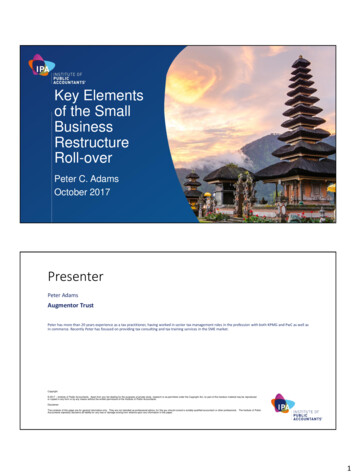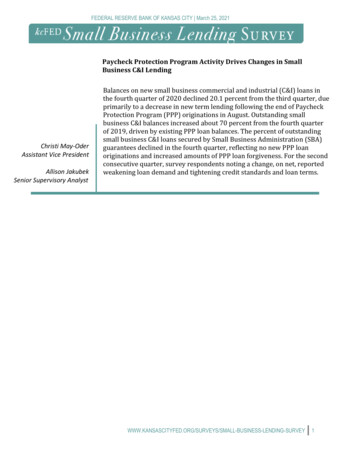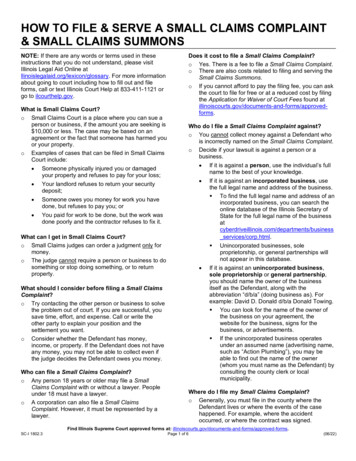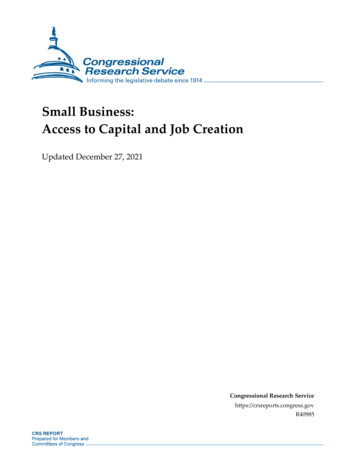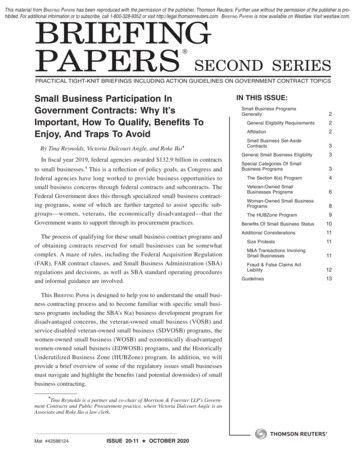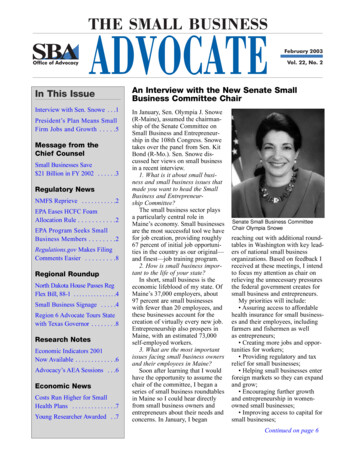
Transcription
THE SMALL BUSINESSFebruary 2003Vol. 22, No. 2In This IssueAn Interview with the New Senate SmallBusiness Committee ChairInterview with Sen. Snowe . . .1In January, Sen. Olympia J. Snowe(R-Maine), assumed the chairmanship of the Senate Committee onSmall Business and Entrepreneurship in the 108th Congress. Snowetakes over the panel from Sen. KitBond (R-Mo.). Sen. Snowe discussed her views on small businessin a recent interview.1. What is it about small business and small business issues thatmade you want to head the SmallBusiness and Entrepreneurship Committee?The small business sector playsa particularly central role inMaine’s economy. Small businessesare the most successful tool we havefor job creation, providing roughly67 percent of initial job opportunities in the country as our original—and finest—job training program.2. How is small business important to the life of your state?In short, small business is theeconomic lifeblood of my state. OfMaine’s 37,000 employers, about97 percent are small businesseswith fewer than 20 employees, andthese businesses account for thecreation of virtually every new job.Entrepreneurship also prospers inMaine, with an estimated 73,000self-employed workers.3. What are the most importantissues facing small business ownersand their employees in Maine?Soon after learning that I wouldhave the opportunity to assume thechair of the committee, I began aseries of small business roundtablesin Maine so I could hear directlyfrom small business owners andentrepreneurs about their needs andconcerns. In January, I beganPresident’s Plan Means SmallFirm Jobs and Growth . . . . .5Message from theChief CounselSmall Businesses Save 21 Billion in FY 2002 . . . . . .3Regulatory NewsNMFS Reprieve . . . . . . . . . . .2EPA Eases HCFC FoamAllocation Rule . . . . . . . . . . .2EPA Program Seeks SmallBusiness Members . . . . . . . .2Regulations.gov Makes FilingComments Easier . . . . . . . . .8Regional RoundupNorth Dakota House Passes RegFlex Bill, 88-1 . . . . . . . . . . . . . . .4Small Business Signage . . . . .4Region 6 Advocate Tours Statewith Texas Governor . . . . . . . .8Research NotesEconomic Indicators 2001Now Available . . . . . . . . . . . . .6Advocacy’s AEA Sessions . . .6Economic NewsCosts Run Higher for SmallHealth Plans . . . . . . . . . . . . . .7Young Researcher Awarded . .7Senate Small Business CommitteeChair Olympia Snowereaching out with additional roundtables in Washington with key leaders of national small businessorganizations. Based on feedback Ireceived at these meetings, I intendto focus my attention as chair onrelieving the unnecessary pressuresthe federal government creates forsmall business and entrepreneurs.My priorities will include: Assuring access to affordablehealth insurance for small businesses and their employees, includingfarmers and fishermen as wellas entrepreneurs; Creating more jobs and opportunities for workers; Providing regulatory and taxrelief for small businesses; Helping small businesses enterforeign markets so they can expandand grow; Encouraging further growthand entrepreneurship in womenowned small businesses; Improving access to capital forsmall businesses;Continued on page 6
The Small Business AdvocateRegulatory NewsSmall Fishermen Win Reprieve withNMFS DecisionSmall New England fishermen wona reprieve in January as theNational Marine Fisheries Service(NMFS) decided to give the industry five extra years to rebuilddepleted stocks of cod and othergroundfish. Advocacy had askedfor such an action in an earlier letter to the New England FisheryManagement Council. “A less burdensome way to rebuild groundfishstocks has been found by considering the concerns of small fishermenin the regulatory process,” saidBarbara Manning, New Englandregional advocate for the Office ofAdvocacy. “Well-managed fisheriesdepend on sound science, and itappears the recent decision byNMFS will allow scientists thetime necessary to assess thestrength of the various species.I applaud them for their decision,”she said. Advocacy research hasshown that 99 percent of the fishingindustry consists of small businesses.EPA Listens To Small Business ConcernsAbout HCFC Foam AllocationAfter listening to the concerns ofsmall business, the EnvironmentalProtection Agency (EPA) issued afinal rule that will allow limitedproduction of certain hydrochlorofluorocarbons (HCFCs) beyondJanuary 2003. The Office ofAdvocacy worked closely with theEPA, industry members, and suppliers to help shape a final rule thataddressed the concerns of smallbusinesses while still protecting theenvironment. “This was a great collaborative effort by all parties toachieve regulatory relief for smallbusiness that makes environmentalsense. It’s a win/win solution,”said Chief Counsel Thomas M.Sullivan. “EPA showed a willingness to overcome its initial assumptions and dig into the hard technicaldata. EPA has found that smallindustrial firms need more time toovercome challenges in developingfoam formulas based on alternativesto HCFC-141b. These challengesare especially tough since the alternatives must meet worker safety,flammability, building code, andother standards,” he added.HCFC-141b is a critical blowingagent used, among other things, tomake highly efficient insulatingpolyurethane foams. EPA’s finalrule allows spray-and-pourpolyurethane foam industry mem-Editor Rebecca KrafftManaging Editor Rob KleinsteuberContributing Editors Major Clark, ChadMoutray, John McDowell, Kathryn TobiasProduction Assistant Darlene MoyeMahmoudThe Small Business Advocate (ISSN1045-7658) is published monthly by theU.S. Small Business Administration’sOffice of Advocacy and is distributed toSmall Business Administration field staffand members of the U.S. Congress. TheSmall Business Advocate is availablewithout charge from the Office of Advocacy,U.S. Small Business Administration,Mail Code 3114, Washington, DC 20416.Send address changes to: The SmallBusiness Advocate, Mail Code 3114,U.S. Small Business Administration,Washington, DC 20416. Include yourcurrent address label.The Small Business Advocate online:www.sba.gov/advo/news/Electronic delivery of The Small BusinessAdvocate is available by visitingwww.sba.gov/advo/news/. Subscriberinformation will be kept confidential andnot used for any purpose except fornewsletter delivery. To discontinue printdelivery of The Small Business Advocate,send an email with your current mailinginformation to advocacy@sba.gov or call(202) 205-6533.Federal Recycling ProgramPrinted on recycled paper.bers, who lack viable alternatives,to stay in business as long as theydemonstrate that they are makingprogress transitioning to alternatives.Performance Track Program Seeks More Small Business MembersThe Office of Advocacy, in partnership with EPA, encourages smallbusinesses to consider participatingin EPA’s National PerformanceTrack Program. Launched in mid2000, the program provides recognition and incentives to top environmental performers. It is open tofacilities of all types, sizes, andcomplexity; public or private; manufacturing or service-oriented.There are currently over 300 mem-The Small Business Advocatebers. Benefits of participating include a reduced likelihood of EPAinspections, reduced regulatorytransaction costs, increased accessto EPA officials, and recognitionand networking opportunities.Facilities are chosen based on theirsystematic approach to environmental management, commitmentto continuous improvement, soundcompliance history, and willingnessto reach out to the community.page 2To assist small businesses whomight be interested in joining thePerformance Track Program, EPAhas relaxed the admission requirements for facilities with fewer than50 employees. Applications arebeing accepted until April 30, 2003.Additional information, includingapplication materials, can be foundat www.epa.gov/performancetrackor call 1-888-339-PTRK.February 2003
Message from the Chief CounselSmall Business Saves 21 Billion in Regulatory Costs in FY 2002by Thomas M. Sullivan, Chief Counsel for AdvocacySmall businesses saved 21 billionin regulatory costs with the Officeof Advocacy’s help in fiscal year2002. And in years to come, theystand to save billions more as federal agencies become more proficient at considering small businessconcerns early in the rulemaking process.The Regulatory Flexibility Act(RFA), as amended by the SmallBusiness Regulatory EnforcementFairness Act, requires federal agencies, as a part of their rulemaking,to consider regulatory alternativesto minimize the impact on smallbusinesses and other small entitieswhile achieving the stated objectiveof the regulation. Our office monitors agency compliance with theRFA and reports the findings everyyear to Congress and the President.And we’ve just issued our annual Report to Congress on the RFAfor fiscal year 2002. The reporthighlights key RFA achievementsas well as ongoing concerns relatedto agency compliance with the law.Fiscal year 2002 was an excitingyear for regulatory relief. PresidentBush, who has been a real friend ofsmall business, added a new tool tothe toolkit—Executive Order13272. In it, President Bush directed federal agencies to tear downregulatory barriers to job creationand to give small business owners avoice in the complex and confusingfederal regulatory process. E.O.13272, “Proper Consideration ofSmall Entities in AgencyRulemaking,” underscores agencies’ obligations and givesAdvocacy the job of teaching agencies how to improve their compliance with the RFA.I’m happy to report that even atthe beginning of implementingE.O. 13272, we’re already seeingThe Small Business Advocate“If agencies follow thePresident’s direction, myoffice will be applaudingmore agencies on theirsmall entity-friendlyproposals.”results, as agencies consult withAdvocacy and ask for training earlier in the rule developmentprocess. Our involvement in theregulatory process increasinglyoccurs at the preproposal anddevelopment stages. And our experience shows that the earlier agencies consider small business concerns, the more effective they are inmeeting the RFA’s intent.In FY 2002, the Office ofAdvocacy’s efforts to improveagency compliance with the RFAsaved more than 21 billion infirst-year cost savings, with anadditional 10 billion in annuallyrecurring savings. Revisions madeby the Environmental ProtectionAgency (EPA) to its Cross MediaElectronic Reporting and RecordKeeping Rule produced an estimated savings of 18 billion. Earlyversions of the rule would haverequired any facility using a computer to keep records for EPA toretrofit their computer systems, at aper-business, per-system cost forretrofit estimated at 40,000 upfront and 17,000 annually. Wecommend EPA for revisiting andrevising the recordkeeping portionof the rule.Although a valid cost savings,the EPA rule is extraordinary in itssheer magnitude; without that rule,Advocacy’s interventions resultedin more than 3 billion in first-yearcost savings. We salute the achievements of our federal agency partners who used scientific and ecopage 3nomic data and adopted the recommendations of the small businesscommunity to reduce the smallbusiness burden of their rules.Looking ahead to fiscal year 2003,we think that cost savings will continue to increase as E.O. 13272 isfully implemented.But you know what? I hope thatthe specific amount of money wecan claim to have saved small business actually drops in the future.That’s because I believe that asagencies request the Office ofAdvocacy’s input earlier in therulemaking process and improvetheir RFA compliance, the cost savings achieved by Advocacy afterthe publication of a proposed rulewill decrease. If agencies followthe President’s direction, my officewill be applauding more agencieson their small entity-friendly proposals. This contrasts with our traditional role—criticizing overlyburdensome regulatory mandatesand documenting cost savings oncean agency reconsiders its position.The Office of Advocacy is available as a resource to assist federalagencies with their small entity outreach and to provide training tofederal agencies and small entitieson the RFA. Under ExecutiveOrder 13272, we have publishednew guidance on how to complywith the RFA, and Advocacy willprovide governmentwide trainingon RFA compliance over the coming year. For additional informationabout our efforts to implementExecutive Order 13272, and toview Advocacy’s RFA guide, comment letters, and testimony, pleasevisit Advocacy’s website atwww.sba.gov/advo.February 2003
Regional RoundupNorth Dakota House Passes State Regulatory Flexibility Bill, 88-1On Jan. 15, the North DakotaHouse Industry, Business, andLabor Committee held a hearing onHB 1212, the North Dakota StateRegulatory Flexibility Act. The billwould require state agencies to prepare an economic impact statementbefore they adopt new rules thatwould have an adverse effect onsmall businesses. The measuredefines a small business as onewith fewer than 25 full-time workers. The bill was introduced byRep. Mark Dosch (R-Bismarck),who is himself a small businessowner. HB 1212 enjoys bipartisansponsorship and it was voted out ofcommittee by a 12-1 vote.On Jan. 31, the North DakotaHouse of Representatives passedHB 1212 by a vote of 88-1.Supporters of HB 1212, the North Dakota Reg Flex Act, from left: Region 8Advocate Jim Henderson; Rep. Mary Ekstrom (D-Fargo); House Industry, Businessand Labor Committee Chairman George Keiser; (R-Bismarck), Rep. Mark Dosch(R-Bismarck); and Bill Butcher, state director of the North Dakota office of theNational Federation of Independent Business.Commercial Signage and Its Importance to Small BusinessMost small business owners areaware of the regulations pertainingto the display and content of signage. To the extent that some signregulations may unduly burdensmall businesses, they may need tobe revised, first to facilitate smallbusiness success, and at the sametime to benefit state and local governments and economies. TheOffice of Advocacy is activelyworking to make state governmentscognizant of the uneven impact ofmany regulations through the stateregulatory flexibility initiative.Many fledgling small businessesare totally dependent on commercialsignage for their customers or retailsales. Without an on-premises sign,these businesses cannot competewith larger chains and franchises. Asmall business’s on-premises signcan function in a number of waysto benefit the business. It identifiesthe business, it builds brand aware-The Small Business Advocateness, and promotes impulse sales.The on-premises sign can be thelinchpin of success for many categories of small business.A sign’s importance is illustratedin a survey conducted over the1997-1999 period by GulfIndustries of Torrance, Calif.During the two-year study, 165independent small businesses surveyed between 15 and 30 of theirfirst-time customers or clients todetermine what prompted their firstvisit. In all, 2,475 new customerswere surveyed. When asked thequestion, “How did you learn aboutus?” Fifty percent responded thatthe company’s sign was their firstexposure to the business. Hence, abusiness’s sign can be estimated togenerate between 15 percent and 45percent of a small firm’s revenue.Businesses in the United Statessell retail goods at prices 15 to 50percent lower than the going ratespage 4in Europe and Japan. Yet U.S. businesses spend almost three timesmore on marketing and advertising.Business signage is an integral andessential component of U.S. businesses’ marketing and advertisingstrategies, and by extension, oftheir success.Legally speaking, commercialsignage is regulated through eachstate’s sovereign power to regulateland use. States may delegate someof this authority to their local unitsof government. For most of the 20thcentury, small businesses had tocarry the burden of proof that suchregulations harmed them becausethe courts created a presumptionthat these regulations were constitutional. This burden of proof wasso heavy that it created a barrier tochallenge regulatory land use andcommercial signage decisions madeby the states or their localities.Continued on page 5February 2003
President’s Plan Means Jobs and Growth for Small Businessby Chad Moutray, Chief Economist, Office of AdvocacyThe President’s economic plan willcreate jobs and growth in everystate. Much is made of two provisions in the plan—accelerating thetax cuts enacted in 2001 and eliminating the double taxation of dividends. But, there is an equallyimportant feature that is of greatimportance to the 23 million smallbusinesses in the United States andtheir employees.The President’s growth and jobsplan increases the amount of equipment purchases a small businesscan immediately expense, ratherthan depreciate over time, from 25,000 to 75,000. This newamount is permanent and indexedto inflation. This is a major incentive for small firms to invest in newcapital equipment, which will serveas a powerful tool for growth assmall businesses are a dominantforce in the economy, both in termsof jobs and economic output.Expanding the eligible write-offsfor small business investments hasstrong support in the small businesscommunity. All White House Conferences on Small Business haverecommended increases in directexpensing. Moreover, the Office ofAdvocacy has long supported proposals to increase such write-offsand testified in support of thischange before the Senate FinanceCommittee in March of 2001.View this incentive for smallbusiness growth from an economicSignage, from page 4In the 1980s, the courts began totake a different view. TheodoreOlson (now the U.S. solicitor general) won a landmark case,Metromedia, Inc., v. City of SanDiego, which for the first timeextended First Amendment protection to the realm of land use planning insofar as it affects commerThe Small Business Advocate“The President’s growthand jobs plan increasesthe amount of equipmentpurchases a smallbusiness can immediatelyexpense, rather thandepreciate over time,from 25,000 to 75,000.”development perspective. It is morethan simply tinkering with the taxcode. A 1998 National Bureau ofEconomic Research working paperconcluded that marginal tax ratechanges significantly change investment spending patterns. The studysuggested that tax rate changeswould alter the cost of capital fornew investment decisions, and thatlower tax rates would make moreprojects viable. They are not alonein this analysis as other studieshave found similar links betweentaxation and investment.The President got it right byfocusing on jobs and long-termgrowth. From an economic perspective, small businesses wouldbenefit most by making the increased deductions for small businessexpensing permanent. Short horizontax benefits might result in someincreases in equipment purchases,but any increases would be shortlived. Once the short-term incentives expire, any benefits wouldvanish with them. An approach thatcial signage. Today, a sign code isnot presumed to be constitutional.The government must prove that itssign code is a content-neutral regulation of time, place, and mannerof display.Because of its critical importance to business success, smallbusinesses should be aware of howto make the most of their commercial signage. To this end, SBA haspage 5is more permanent and predictablefor small businesses would yieldgreater results as capital spendingpatterns from year to year wouldrise. Permanent expanded expensing creates a successful incentivefor small businesses to invest andcreate more jobs.It is refreshing to see the discussion focus on small business and itseffects on the economy. Researchsponsored by the Office of Advocacy has shown that small businessaccounts for more than half of thenation’s private gross domesticproduct, and small firms employover half of the private work force.There are 5.6 million smallemployer businesses. If due to thePresident’s plan on average theyincreased their equipment purchases by only 10,000, almost 56 billion would be pumped into theeconomy annually, creating jobsand expanding the tax base. Moreimportant, the nation would reapthe reward of having significantlyhigher investments in equipment ata time when capital spending has remained stagnant nationwide, causinga drag on our recovering economy.Americans should eagerly support initiatives that increase equipment write-offs for small businesses. These proposals are fundamentally sound, and they will provide anecessary incentive to drive jobcreation and economic growth.launched an educational websitedealing with on-premises businesssignage. Visit this excellent resourceat www.sba.gov/starting/signage.February 2003
Research NotesAdvocacy Sponsors Small Business Sessions at AEA Annual MeetingAdvocacy’s Office of EconomicResearch organized three sessionson small business research at theAmerican Economic Associationannual meeting in January, a first forthe office. The three sessions were: Firm Organization andStructure of Small Business,chaired by Zoltan Acs of theUniversity of Baltimore; Small Business Dynamics,chaired by Alicia Robb of theFederal Reserve Board; and Entrepreneurs andEntrepreneurship, chaired by JoshuaLerner of Harvard Business School.The papers presented and theirauthors are listed below.The Two Faces of Entrepreneurship: Evidence from Easternand Western Europe, by MihirDesai, Josh Lerner and PaulGompers. Contact jlerner@hbs.edu.Economic Growth andEntrepreneurial Activity: AnEmpirical Analysis, by Zoltan Acsand Catherine Armington. Contactzacs@UBmail.ubalt.edu andasegra@usa.net.The Entrepreneur andEntrepreneurship: A NeoclassicalApproach, by Ying Lowrey.Contact ying.lowrey@sba.gov.Family Resources, Race, andSmall Business Outcomes, byRobert Fairlie and Alicia Robb.Impact of Tight Money and/orRecessions on Small Business byKathryn Kobe, Rakesh Kochharand Joel Popkin. Contact:rkochhar@jpcecon.com.Income and Wealth: How DidHouseholds Owning SmallBusinesses Fare From 1992 to1998, by George Haynes andCharles Ou. Contact:charles.ou@sba.gov.The Effect of ComputerNetworks on Small and Large U.S.Manufacturing Plants’ Produc-tivity: New Evidence from theCNUS Data, by B.K. Atrostic andSang V. Nguyen. Contact: batrostic@ces.census.gov andsnguyen@ces.census.gov.Productivity Growth and FirmSize Distribution, by Zoltan Acs,Juan Alcacer and Bernard Yeung.Contact: zacs@UBmail.ubalt.edu,jalcacer@stern.nyu.edu, and byeung@stern.nyu.edu.Main Street in the Digital Age:How Small and Medium-SizedBusinesses Are Using the Tools ofthe New Economy, by PatriciaBuckley and Sabrina Montes. Contact: patricia.buckley@esa.doc.govand sabrina.montes@esa.doc.gov.Business Closures: Checkingthe Assumptions of ClosuresBeing Considered Failures andClosure Rates Being High, byBrian Headd. Contact:brian.headd@sba.gov.Senator Snowe, from page 1legislative and regulatory initiativescan produce tremendous benefitsfor our nation’s Main Street and theeconomy as a whole. Part of myjob as chair of the committee willbe to work to ensure that the smallbusiness sector is not left behind asthe 108th Congress works to getthe economy growing again. Increasing access and utilization of new technologies and ecommerce by small businesses; and Assuring improved availabilityof worker education and training.4. What have you learned aboutAmerican small business that youwish your senatorial colleaguesknew as well?Unfortunately, I have found thatdespite the role small businessesplay in growing our economy, government too often frustrates theirefforts. In reality, the future of ourcountry is tied to the future ofsmall business—and by enhancingthe conditions that support smallbusiness, we will ensure a moreprosperous future for all. Especiallywhen the economy is slow, manymembers of Congress tend to focusnarrowly on the big economic picture and forget that finely targetedThe Small Business AdvocateSmall Business Economic Indicators for2001 ReleasedIn February, the Office of Advocacy released its annual referenceguide to the latest small business data, Small Business EconomicIndicators for 2001. The data give a picture of a weakened economyand signs of small businesses struggling: rising business bankruptciesand tightened financial markets. Overall, however, the total number ofU.S. employer firms remained relatively level, rising from an estimated 5.7 million in 2000 to an estimated 5.8 million in 2001. Selfemployment remained relatively unchanged as well, going from 9.9million in 2000 to 9.8 million in 2001.The report contains extensive U.S. data and information by statewhere available. It lists the number of businesses, new employerfirms, business terminations, and bankruptcies; lending terms andstandards for 2001 and years prior; employment information; andfastest growing industries. The complete report is available online atwww.sba.gov/advo/research.page 6February 2003
Economic NewsCosts Run Higher for Small Group Health Insurance PlansSmall group health plans are morecostly to administer than plans forlarger businesses, according to anew Advocacy report. A Study ofthe Administrative Costs andActuarial Values of Small HealthPlans examined 19 health careplans in two states. It was writtenby Rose Chu and Gordon Trapnellof Actuarial Research Corporationfor the Office of Advocacy. Theauthors found that administrativeexpenses for insurers of smallgroup health plans ranged from 33to 37 percent of claims, versus 5 to11 percent of claims for large companies’ self-insured plans. Thereport also found that sales, underwriting, and operating expenseswere all higher for the smallgroup health plans studied versusplans designed for their big business counterparts.“This report is one more piece ofevidence that small businesses neednew options in health care,” saidChief Counsel Tom Sullivan.“Small businesses employ over halfof the private work force, yet manyof their employees remain underinsured due to the high cost of healthcare. This report details the highadministrative costs of health plansdesigned for small business. Oneway to lower these costs would beto spread them across large groupsof small employers throughAssociation Health Plans. I urgeCongress and the President to worktogether to make health care affordable for small employers and theiremployees,” he said.The report is available on theAdvocacy website atwww.sba.gov/advo. Paper andmicrofiche copies of all Advocacyreports are also available for purchase from the National TechnicalInformation Service at (800) 5536847 or through the NTIS websiteat www.ntis.gov.Advocacy Recognizes Best Student Research PaperHow do small firms cooperate witheach other to reach their economicgoals? This is the topic of RobertHartl’s award-winning paper, thefirst recipient of the Office ofAdvocacy’s Best Student Paperaward. Hartl received the award ina Jan. 24 presentation at the annualmeeting of the United StatesAssociation for Small Business andEntrepreneurship. Hartl is a doctoral candidate at the University of St.Gallen, Switzerland.Hartl’s paper won out overstrong international competitionfrom other doctoral candidates. Dr.Chad Moutray, chief economist forAdvocacy, presented the award.“We’re excited about this first BestStudent Paper award,” saidMoutray. “Robert Hartl’s paper setsa high bar for solid academicresearch into the role of small business and entrepreneurship in oureconomy. Research like this provides a strong base for public policy choices that encourage entrepreneurial success, job creation, andeconomic growth.” The paper, ALongitudinal Analysis of Industry,The Small Business AdvocateEnterprise and BehavioralPredictors of SME InterfirmCooperation, is available as part ofAdvocacy’s working paper series,located at www.sba.gov/advo/stats/wkpaper.html.Dr. Ying Lowrey, senior economist with the Office of Advocacy, and Best StudentPaper recipient, Robert Hartl.page 7February 2003
Regulations.govMakes FilingComments EasierRegion 6 Advocate Till Phillips (left) and Texas Gov. Rick Perry discussed economic development and regulatory issues on a recent tour. They are pictured hereat the Air Motor Company, a windmill manufacturer in San Angelo, Texas.Regional Advocate on Tour with Texas GovernorIn August, Region 6 AdvocateG. Till Phillips accompanied TexasGov. Rick Perry on the multicityTrade Routes tour. Also participating were officials from the U.S.Department of Commerce, the U.S.Chamber of Commerce, and theU.S. Small Business AdministrationOffice of AdvocacyMail Code 3114409 Third Street, S.W.Washington, DC 20416Official UsePenalty for Private Use, 300Return Service RequestedTexas Economic DevelopmentCommission. The delegation madestops in eight towns in west andsouthwest Texas and visited fivesmall businesses. A total of 1,345people attended the tour events.Now, there’s a federal government website that facilitates public input in the regulatoryprocess. The site, www.regulations.gov, is the U.S. governmentwebsite where anyone can find,review, and submit comments onfederal documents that are openfor comment and published inthe Federal Register, the government’s legal newspaper. Searchbuttons allow you to find rules,and specific comment linksmake it easier than ever before toexpress your opinion on a specific document. You can search forrules by keyword—or by federalagency. The site is a great leapforward in making governmentopen and transparent: anyonewith a computer and Internetaccess can find every pendingfederal regulation that is open forcomment, read it,and submit theirviews.FIRST CLASSPOSTAGE AND FEES PAIDU.S. Small Business AdministrationPermit No.G-82
Small Business and Entrepreneur-ship in the 108th Congress. Snowe takes over the panel from Sen. Kit Bond (R-Mo.). Sen. Snowe dis-cussed her views on small business in a recent interview. 1. What is it about small busi-ness and small business issues that made you want to head the Small Business and Entrepreneur-ship Committee? The small .



